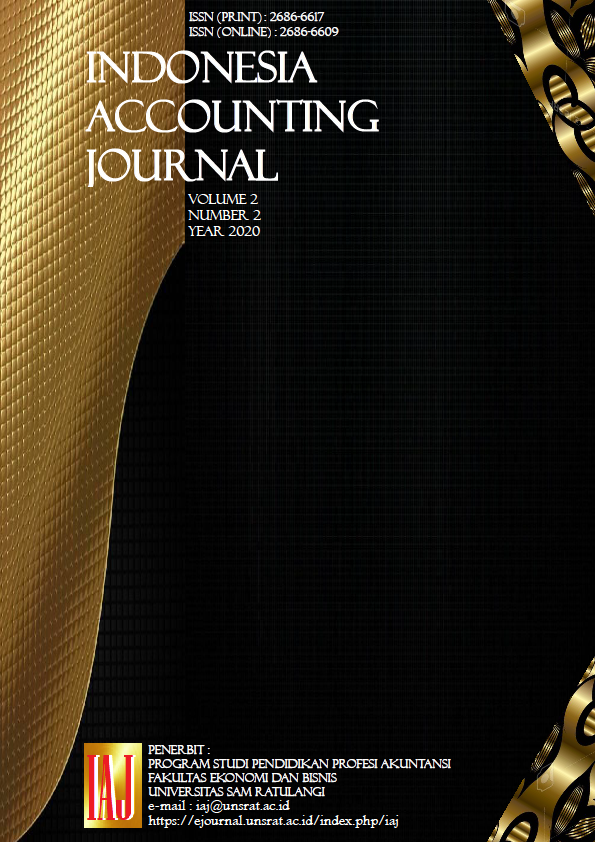Analisis determinan deposito mudharabah
DOI:
https://doi.org/10.32400/iaj.28894Keywords:
mudharabah, inflations, interest, deposit, profit sharingAbstract
The objective of this study is to test the influence of inflation rates, interest rates, liquidity rates proxied by the finance to deposit ratio, and profit sharing rates to the amount of mudharabah deposit. This study conducts the regression analysis and uses time series data which retrieved from the quarterly financial statements of BRI Syariah and BCA Syariah in Indonesia over period of 2014 to 2018 as the sample. The study proves that: (a) the inflation rates is insignificant to influence the amount of deposit mudharabah; (b) the interest rates is insignificant to influence the amount of deposit mudharabah of BRI Syariah and BCA Syariah because when the interest of conventional bank increase then the amount of deposit mudharabah do not experience dramatic changes because the customers still invest their fund at BRI Syariah and BCA Syariah; (c) finance to deposit ratio is significant to influence the amount of mudharabah deposit; (d) the rates of share profit is insignificant to influence the amount of mudharabah deposit; and (e) size is insignificant to influence the amount of mudharabah deposit.
References
Abdurahim, A. (2015). Mendeteksi earning management. Journal of Accounting and Investment, 1(2), 104-111. https://journal.umy.ac.id/index.php/ai/article/view/502
Adisetiawan, R. (2013). Analisis pengaruh kinerja keuangan dalam memprediksi pertumbuhan laba. Jurnal Aplikasi Manajemen, 10(3), 669-681. https://jurnaljam.ub.ac.id/index.php/jam/article/view/452
Alinda, R. P. N.,& Riduwan, A. (2016). Pengaruh tingkat suku bunga dan nisbah bagi hasil pada Deposito Mudharabah. Jurnal Ilmu dan Riset Akuntansi, 5(1).1-15.http://jurnalmahasiswa.stiesia.ac.id/index.php/jira/article/view/1475
Andriyanti, A.,& Wasilah. (2010). Faktor-faktor yang mempengaruhi jumlah penghimpunan dana pihak ketiga (Deposito Mudharabah 1 bulan) Bank Muamalat Indonesia (BMI). Simposium Nasional Akuntansi, 13.http://lib.ibs.ac.id/materi/Prosiding/SNA%20XIII%20(simposium%20nasional%20akuntansi%20XIII)%20Unsud/makalah/AKSR_23.pdf
Anisah, N., Riduwan, A., & Amanah, L. (2013). Faktor-faktor yang mempengaruhi pertumbuhan deposito Mudharabah Bank Syariah. Jurnal Ilmu dan Riset Akuntansi, 1(2), 169-186.
Dewi, I., Yadnyana, I., & Sudana, I. (2016).Pengaruh profitabilitas dan ukuran perusahaan terhadap ketepatwaktuan penyampaian laporan keuangan dan implikasinya pada earning response coefficient.E-Jurnal Ekonomi dan Bisnis Universitas Udayana, 5(9), 3031-3056.https://ojs.unud.ac.id/index.php/EEB/article/view/20181
Farizi, F. A.,&Riduwan, A. (2016). Pengaruh inflasi, suku bunga, likuiditas, dan bagi hasil terhadap Deposito Mudharabah. Jurnal Ilmu dan Riset Akuntansi, 5(4).1-16.http://jurnalmahasiswa.stiesia.ac.id/index.php/jira/article/view/1717
Hall, M., & Weiss, L. (1967).Firm size and profitability.The Review of Economics and Statistics, 49(3), 319-331. https://doi.org/10.2307/1926642
Haron, S. (2004). Determinants of Islamic Bank profitability.Working Paper. https://ie.um.ac.ir/images/329/Articles/Others/Latin/Determinants%20of%20Islamic%20Bank%20Profitability.pdf2.pdf
Hartono, J. (2017). Teori portofolio dan analisis investasi, Edisi 11.Yogyakarta: BPFE.
Iskandar, D., & Firdaus, I. (2014).Pengaruh tingkat suku bunga, inflasi, kurs Rupiah terhadap Deposito Mudharabah dan Deposito Mudharabah Bank Konvensional pada perbankan di Indonesia.Jurnal Ilmu Ekonomi dan Sosial, 2(3). 336-344.http://digilib.mercubuana.ac.id/manager/t!@file_artikel_abstrak/Isi_Artikel_643223141863.pdf
Karim, A.A. (2010). Bank Islam (analisis fiqih dan keuangan). Jakarta: PT. Raja Grafindo Persada.
Kasmir.(2015). Analisis laporan keuangan. Jakarta: PT Raja Grafindo Persada.
Majelis Ulama Indonesia. (2005). Himpunan Keputusan Musyawarah Nasional VII Majelis Ulama Indonesia. Jakarta: Sekretariat MUI.
Martono. (2002). Bank dan lembaga keuangan lain. Yogyakarta: Ekonisia.
Nofianti, N., & T. Badina, & Erlangga, A. (2015).Analisis pengaruh Return On Asset (ROA), Biaya Operasional Terhadap Pendapatan Operasional (BOPO), suku bunga, Financing to Deposits Ratio (FDR) dan Non Performing Financing (NPF) terhadap tingkat bagi hasil deposito Mudharabah (Studi empiris pada Bank Umum Syariah di Indonesia tahun 2011-2013). ESENSI: Jurnal Bisnis dan Manajemen, 5(1), 65-86.https://doi.org/10.15408/ess.v5i1.2333
Perwataatmadja, K., & Antonio, M. S. (1992). Apa dan bagaimana Bank Islam. Yogyakarta: Dana Bhakti Wakaf.
Pratiwi, R.,& Lukmana, A. (2015). Pengaruh kurs valuta asing dan tingkat bagi hasil terhadap volume Deposito Mudharabah USD pada Perbankan Syariah (periode Januari 2011-Maret 2015). Jurnal Ekonomi dan Perbankan Syariah, 3(1),55-68.
Puspopranoto, S. (2004).Keuangan perbankan dan pasar keuangan. Jakarta: Pustaka LP3ES Indonesia.
Rahman.A. (2011). Investasi cerdas. Jakarta: Gagas Media.
Rahmawaty, &Yudina, T. A. (2015). Pengaruh Return On Asset (ROA) dan Financing to Deposit Ratio (FDR) terhadap tingkat bagi hasil Deposito Mudharabah pada Bank Umum Syariah. Jurnal Dinamika Akuntansi dan Bisnis, 2(1), 92-103.http://jurnal.unsyiah.ac.id/JDAB/article/view/3623
Rivai, V., & Arifin, A. (2010). Islamic Banking sebuah teori, Konsep, dan aplikasi. Jakarta: PT Bumi Aksara.
Ruslizar, & Rahmawaty. (2016). Pengaruh tingkat bagi hasil Deposito Mudharabah, deposit ratio, dan suku bunga Deposito Mudharabah terhadap pertumbuhan Deposito Mudharabah pada Bank Umum Syariah di Indonesia. Jurnal Ilmiah Mahasiswa Ekonomi Akuntansi (JIMEKA), 1(2), 84-90.http://jim.unsyiah.ac.id/EKA/article/view/801
Rodoni, A., & Hamid, A. (2008). Lembaga keuangan syariah. Jakarta: Zikrul Hakim.
Sinaga, A. (2017).Analisis pengaruh tingkat suku bunga (BI rate), bagi hasil, inflasi dan harga emas terhadap jumlah deposito mudharabah perbankan syariah periode 2010-2015.Masters thesis, Universitas Islam Negeri Sumatera Utara Medan. http://repository.uinsu.ac.id/6542
Sukirno, S. (2015). Makroekonomi teori pengantar. Jakarta: PT RajaGrafindo Persada.
Wiroso. (2005). Penghimpunan dana dan distribusi hasil usaha Bank Syariah. Jakarta: PT Grafindo.
Downloads
Additional Files
Published
Issue
Section
License
The articles published in Indonesia Accounting Journal are licensed under Creative Commons Attribution 4.0 International License with authors as copyright holders.
Â

This work is licensed under a Creative Commons Attribution 4.0 International License.
Â
Under this license then authors free to:
- Share — copy and redistribute the material in any medium or format.
- Adapt — remix, transform, and build upon the material for any purpose, even commercially.
Under the following terms :
- Attribution — You must give appropriate credit, provide a link to the license, and indicate if changes were made. You may do so in any reasonable manner, but not in any way that suggests the licensor endorses you or your use.
- No additional restrictions — You may not apply legal terms or technological measures that legally restrict others from doing anything the license permits.
Notices:
- You do not have to comply with the license for elements of the material in the public domain or where your use is permitted by an applicable exception or limitation.
- No warranties are given. The license may not give you all of the permissions necessary for your intended use. For example, other rights such as publicity, privacy, or moral rights may limit how you use the material.


